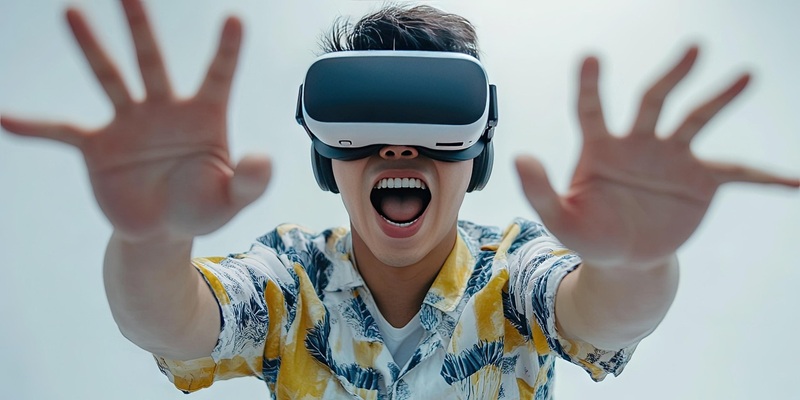Virtual Reality Experiences: A New Frontier in Immersive Technology

Virtual Reality (VR) has changed from a niche technological novelty to a transformative force reshaping industries and human interaction. Today, VR is no longer confined to science fiction or expensive laboratory prototypes. Instead, it has become a new frontier that is rapidly influencing how we work, play, and communicate.
Understanding the Foundation: What is Virtual Reality?
Virtual Reality is a simulated experience that can be similar to or completely different from the real world. It immerses users in a computer-generated environment, often using a headset that tracks head movement and vision. In addition, hand controllers and motion sensors enhance interactivity, making the virtual world feel incredibly real.
Although the concept has been around since the mid-20th century, it is only in the past decade that technological advancements have made VR more accessible and commercially viable. Furthermore, improvements in graphic rendering, motion detection, and user interface design have propelled VR into mainstream usage.
The Key Technologies Driving Virtual Reality Experiences
To fully appreciate the potential of virtual reality, it’s essential to understand the components that make these experiences possible. Modern VR systems incorporate several crucial technologies:
Head-Mounted Displays (HMDs): Devices like the Oculus Quest, HTC Vive, and PlayStation VR offer immersive visual and auditory experiences. These headsets provide stereoscopic displays and head-tracking to simulate depth and motion.
- Motion Tracking Sensors: These sensors monitor body movement and translate them into virtual actions. Consequently, users feel more physically involved in virtual spaces.
- Haptic Feedback Devices: Gloves, suits, and handheld controllers deliver tactile sensations, further enhancing immersion by simulating touch and resistance.
- Artificial Intelligence and Machine Learning: AI is integrated into VR to create intelligent, adaptive environments that respond to user behavior in real-time.
- Spatial Audio: Realistic 3D sound design plays a pivotal role in making the experience immersive. Therefore, it helps users perceive distance, direction, and ambiance more naturally.
- Immersive Entertainment: Redefining Gaming and Cinema
One of the most obvious and widespread applications of VR is in entertainment. Gaming, in particular, has embraced virtual reality wholeheartedly.
Gaming in a Fully Immersive Environment
Unlike traditional gaming, where players interact through screens and controllers, VR gaming puts the user inside the game world. Players can physically dodge, duck, and swing their arms, which provides a more intense and rewarding experience. Games like Beat Saber, Half-Life: Alyx, and The Walking Dead: Saints & Sinners illustrate the power of immersive gameplay.
Moreover, social VR games allow friends and strangers to meet, play, and interact in real-time, despite being in different physical locations. This has not only expanded the gaming space but also introduced new possibilities for virtual socialization.
Virtual Reality in Cinematic Experiences
In addition to gaming, VR is revolutionizing the way films are produced and consumed. Virtual reality films and documentaries immerse viewers in the narrative, allowing them to explore scenes from different angles or even interact with characters. As a result, storytelling becomes more engaging and deeply personal.
Virtual Tourism and Travel: Exploring the World from Your Living Room
Another groundbreaking application of virtual reality is virtual tourism. Although nothing can replace real travel, VR offers a surprisingly fulfilling alternative.
Imagine standing atop Machu Picchu, strolling through the streets of Tokyo, or diving into the Great Barrier Reef—all from the comfort of your home. VR enables users to experience these wonders in vivid detail. Furthermore, travel agencies and tourism boards have started using VR to entice potential travelers by giving them a preview of their destinations.
During the COVID-19 pandemic, virtual tours surged in popularity. Museums, historical landmarks, and cultural institutions opened their doors virtually, making global travel possible despite lockdowns and restrictions.
Education and Training: A Safer and More Effective Learning Environment
One of the most valuable aspects of VR is its ability to simulate real-world scenarios for training and educational purposes. Unlike traditional classroom methods, VR immerses students in interactive learning environments that significantly boost retention and engagement.
Medical and Surgical Training
For example, medical students can now perform simulated surgeries in virtual environments, gaining hands-on experience without risking real lives. These simulations can be repeated as often as needed, allowing learners to perfect their skills at their own pace.
Corporate and Industrial Training
Similarly, companies use VR to train employees for hazardous or complex tasks. From oil rig operations to aircraft maintenance, VR training modules allow workers to practice in realistic but controlled settings. This not only reduces training costs but also minimizes on-the-job accidents.
Virtual Workspaces: Redefining Remote Collaboration
With the rise of remote work, virtual reality is transforming digital collaboration. Platforms like Meta’s Horizon Workrooms and Spatial enable teams to meet in shared virtual offices. Here, participants can see avatars of their coworkers, collaborate on 3D models, and interact as if they were in the same room.
Transitioning from flat video calls to immersive meetings enhances engagement and teamwork. In addition, VR workspaces reduce fatigue often associated with prolonged screen time, offering a more natural and interactive working experience.
Health and Therapy: Virtual Reality as a Healing Tool
The therapeutic applications of VR are expanding rapidly. Mental health professionals now use VR to treat conditions such as PTSD, anxiety, and phobias.
Exposure Therapy
For instance, VR exposure therapy allows patients to face and gradually overcome their fears in a safe, controlled environment. A person afraid of flying can take virtual flights repeatedly until their anxiety diminishes.
Pain Management and Rehabilitation
Furthermore, VR has shown promise in pain management. Studies have found that immersive VR experiences can distract patients from pain during procedures or recovery. Likewise, physical therapists use VR games to motivate patients during rehabilitation exercises, making therapy more enjoyable and effective.
Challenges and Ethical Considerations in Virtual Reality
Despite its enormous potential, VR comes with its own set of challenges. These must be addressed to ensure the technology’s sustainable and ethical growth.
Physical and Psychological Effects
Extended VR use can cause motion sickness, eye strain, and fatigue. Additionally, highly immersive content can blur the lines between reality and simulation, which may affect some users psychologically.
Privacy and Data Security
As VR collects vast amounts of personal data—including eye movement, body motion, and emotional responses—it raises serious concerns about privacy. Developers must implement stringent data protection measures and transparent policies to maintain user trust.
Accessibility and Cost
Although prices are gradually declining, high-end VR systems remain unaffordable for many. Bridging the digital divide will be critical to ensuring widespread access to virtual reality experiences.
The Future of Virtual Reality: What Lies Ahead?
The future of VR is both promising and dynamic. As 5G networks roll out globally, they will enable smoother, faster VR experiences. Moreover, the integration of artificial intelligence, blockchain, and cloud computing will further elevate VR’s capabilities.
In the next decade, we can expect virtual reality to become as commonplace as smartphones. From virtual classrooms to online shopping, nearly every aspect of life could be enhanced by immersive technologies.
Additionally, the emergence of the metaverse—a collective virtual shared space—could redefine how we live, work, and socialize. As companies invest billions in building interconnected digital worlds, VR is poised to become the cornerstone of this new digital era.
Conclusion
In summary, virtual reality experiences represent a thrilling new frontier that merges imagination with technology. From gaming and education to healthcare and remote work, VR is reshaping reality as we know it. However, while the potential is vast, responsible development and thoughtful regulation will be key to harnessing its benefits for all.
As we stand on the cusp of this technological revolution, one thing is clear: the age of virtual reality is not just coming—it’s already here. And for those ready to explore, the possibilities are virtually limitless.

Source: Virtual Reality Experiences: A New Frontier in Immersive Technology




